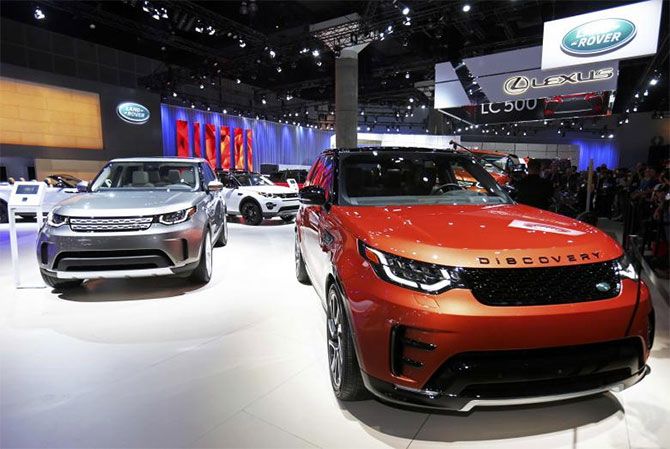The Street’s optimism on India’s largest listed automotive maker by market capitalisation is not misplaced, given the robust wholesale performance in recent months and the strong 2023-24 (FY24) October-December (Q3) results.

Led by its UK-based subsidiary, JLR, Tata Motors’ Q3 results were a comprehensive beat across parameters and marked the fifth consecutive quarter of improved performance.
Brokerages expect the company to maintain its strong performance in the coming quarters.
Further, the operational performance and outlook could support the stock, which has more than doubled since the start of FY24.
Aided by a 25 per cent growth over the year-ago quarter and a 5.2 per cent sequential increase, revenues at just over Rs 1.1 trillion were better than consensus estimates.
The growth over the year-ago quarter was led by the British luxury unit, which posted a 27 per cent increase in car sales.
Sales of the Range Rover portfolio were at an all-time high, with the top trim of Range Rover SV (electric) witnessing bookings of about 16,000 units.
Realisations were helped by a higher preference for the top trim of the range priced at £202,000.
The overall order book stands at 150,000 units at the end of Q3 and should see a drop as the order fulfilment rate improves.
There was a reduction of 19,000 units in the order book in Q3, with the estimate of the overall reduction pegged at 110,000 going ahead as deliveries pick up.
While JLR is expected to end FY24 with volume growth of 24 per cent, growth on a high base is expected to taper to mid-single digits going ahead into 2024-25.
On the domestic front, commercial vehicle revenues grew a healthy 19 per cent even as volumes were up only marginally at 1.1 per cent in the quarter.
The gains were largely due to a sales skew towards medium and heavy commercial vehicles and better pricing for the product portfolio.
While sales of medium and heavy commercial vehicles as well as passenger commercial vehicles were healthy, the smaller and intermediate commercial vehicle sales have witnessed a drop.
The management, however, expects demand to revive in the fourth quarter across segments given the government’s thrust on infrastructure development, the overall growth outlook for the economy, and the company's efforts to drive sales.
On the India passenger vehicle sales, volume growth of 5 per cent year-on-year (Y-o-Y) was aided by an improvement in the supply situation and new refreshes for its sport utility vehicles.
The company seeks to maintain its market share in internal combustion engine (ICE)-powered vehicles (second largest in retail sales) while driving penetration in the electric vehicle (EV) space (where it is the clear market leader) to 15 per cent from 12 per cent.
Even as volume performance was mixed, the key outperformance in the quarter came on the margin front.
The margins at JLR saw the sharpest movement on a Y-o-Y basis, more than doubling to 8.8 per cent from 3.7 per cent a year ago.
The gains were on the back of improved volumes and lower chip-related costs.
The higher margins in JLR in the quarter led to the upward revision of profit margins for FY24 to over 8 per cent.
The company expects operating cash flow to support net debt of less than £1 billion by the end of FY24.
Segment margins for the passenger vehicle business were higher by 60 basis points (bps) Y-o-Y to 2.1 per cent, led by cost savings on the raw material front, although some gains were offset by higher fixed costs.
The operating profit margins for the ICE segment were 20 bps higher on a sequential basis at 9.4 per cent while the EV segment was close to break-even before research and development spends.
The firm is eyeing a double-digit margin for the ICE passenger vehicles while improving the profitability of the EV business.
The commercial vehicle operating profit margins came in at 8.6 per cent and were up 270 bps Y-o-Y on the back of a richer mix, better pricing, and robust realisations.
The company seeks to take the profitability level into double digits for this segment.
Analysts of Emkay Research believe that a strong mix (despite some normalisation from Q3) and healthy profitability would help JLR meet the deleveraging target.
In passenger vehicles, the brokerage expects upcoming launches to aid outperformance amid a weakening industry outlook.
The analysts, however, believe that domestic commercial vehicles will peak in FY24, although margin expectations remain resilient on pricing discipline.
The brokerage has increased its earnings per share estimates after Q3 beat by 3-8 per cent. It has maintained an ‘add’ rating with a higher target price of Rs 925.
BP Equities is also constructive on Tata Motors and is optimistic about the company sustaining its growth momentum.
Disclaimer: This article is meant for information purposes only. This article and information do not constitute a distribution, an endorsement, an investment advice, an offer to buy or sell or the solicitation of an offer to buy or sell any securities/schemes or any other financial products/investment products mentioned in this article to influence the opinion or behaviour of the investors/recipients.
Any use of the information/any investment and investment related decisions of the investors/recipients are at their sole discretion and risk. Any advice herein is made on a general basis and does not take into account the specific investment objectives of the specific person or group of persons. Opinions expressed herein are subject to change without notice.












 © 2025
© 2025